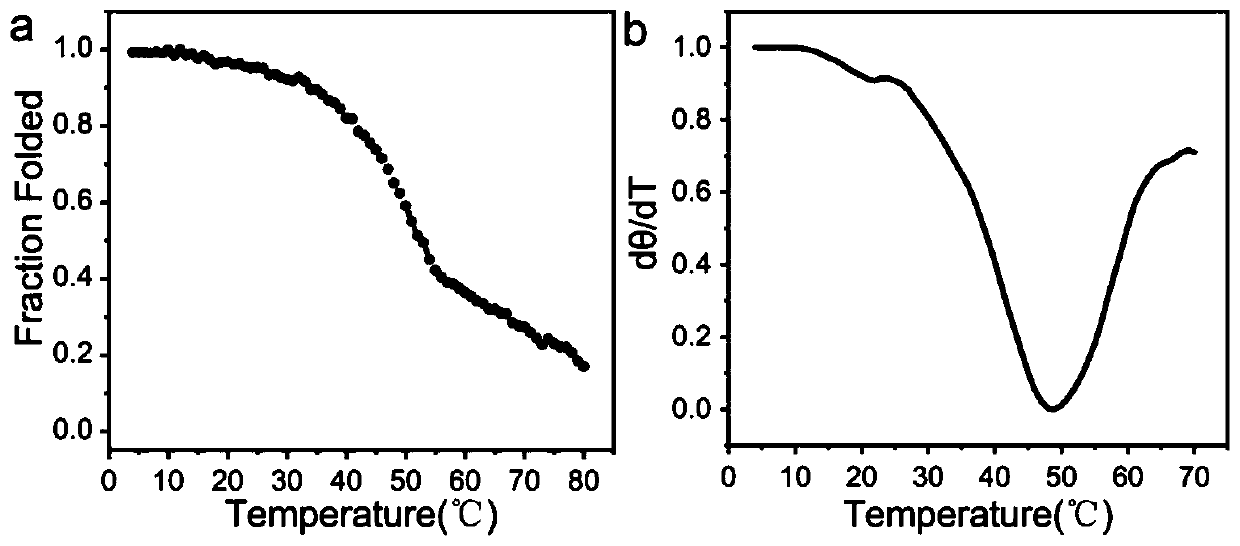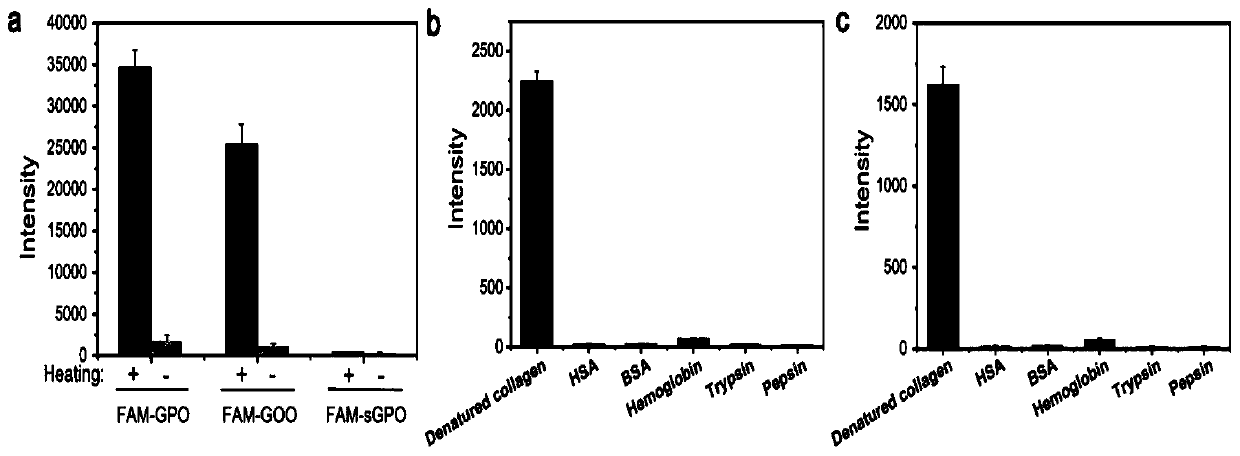Polypeptide probe for targeted recognition of denatured collagen and detection method thereof
A technology of collagen and targeted recognition, which is applied in the preparation method of peptides, chemical instruments and methods, peptides, etc., can solve the problems of increasing the torsion angle of collagen triple helix, unfavorable triple helix structure formation, and triple helix instability. Achieve the effects of good biocompatibility, good targeting ability, and convenient detection
- Summary
- Abstract
- Description
- Claims
- Application Information
AI Technical Summary
Problems solved by technology
Method used
Image
Examples
Embodiment 1
[0045] Embodiment 1 polypeptide probe FAM-G (OOG) 8 preparation of
[0046] The designed peptide sequence is FAM-Gly-(Hyp-Hyp-Gly) 8 , wherein FAM is carboxyfluorescein.
[0047] Probe preparation steps:
[0048] (1) Add 100mg Rink ammonia resin into a reactor with a sieve plate, use 5mL dichloromethane to swell the resin;
[0049] (2) Remove the N-terminal Fmoc protecting group from 20% piperidine / N,N-dimethylformamide (DMF) solution, and detect the complete removal of the protecting group by color reaction;
[0050] (3) Dissolve the amino acid (4eq) protected by Fmoc at the N-terminal, HOBt (4eq) and HBTU (4eq) in DMF, activate at low temperature for 20min, add DIEA (6eq) dropwise to the solution, mix the solution and add it to the reactor , the reaction time is 3hrs.
[0051] (4) After the reaction was finished, the reaction solution was extracted from the reactor, and the resin was washed three times with 5 mL of DMF and DCM respectively. The complete condensation of...
Embodiment 2
[0055] Embodiment 2 polypeptide probe FAM-G (OOG) 10 preparation of
[0056] The designed peptide sequence is FAM-Gly-(Hyp-Hyp-Gly) 10 , wherein FAM is carboxyfluorescein.
[0057] Probe preparation steps:
[0058] (1) Add 100mg Rink ammonia resin into a reactor with a sieve plate, use 5mL dichloromethane to swell the resin;
[0059] (2) Remove the N-terminal Fmoc protecting group from 20% piperidine / N,N-dimethylformamide (DMF) solution, and detect the complete removal of the protecting group by color reaction;
[0060] (3) Dissolve the amino acid (4eq) protected by Fmoc at the N-terminal, HOBt (4eq) and HBTU (4eq) in DMF, activate at low temperature for 20min, add DIEA (6eq) dropwise to the solution, mix the solution and add it to the reactor , the reaction time is 3hrs.
[0061] (4) After the reaction was finished, the reaction solution was extracted from the reactor, and the resin was washed three times with 5 mL of DMF and DCM respectively. The complete condensation ...
Embodiment 3
[0095] Embodiment 3 polypeptide probe FAM-G (OOG) 8 Determination of thermal change temperature curve of
[0096] Get the polypeptide probe FAM-G (OOG) that embodiment 1 prepares 8 And configure it into a 300μM polypeptide probe solution, use circular dichroism to characterize the intensity of the polypeptide probe at 225nm, the temperature of the polypeptide probe solution is increased from 4°C to 75°C, and the heating rate is 1.0°C / min, and each temperature After equilibrating for 2min, measure the thermal change temperature curve of the polypeptide probe under different pH conditions ( figure 1 Shown in a), and according to the curve to make the first derivative of the temperature and normalize to get the normalized curve ( figure 1 shown in b).
PUM
 Login to View More
Login to View More Abstract
Description
Claims
Application Information
 Login to View More
Login to View More - R&D
- Intellectual Property
- Life Sciences
- Materials
- Tech Scout
- Unparalleled Data Quality
- Higher Quality Content
- 60% Fewer Hallucinations
Browse by: Latest US Patents, China's latest patents, Technical Efficacy Thesaurus, Application Domain, Technology Topic, Popular Technical Reports.
© 2025 PatSnap. All rights reserved.Legal|Privacy policy|Modern Slavery Act Transparency Statement|Sitemap|About US| Contact US: help@patsnap.com



